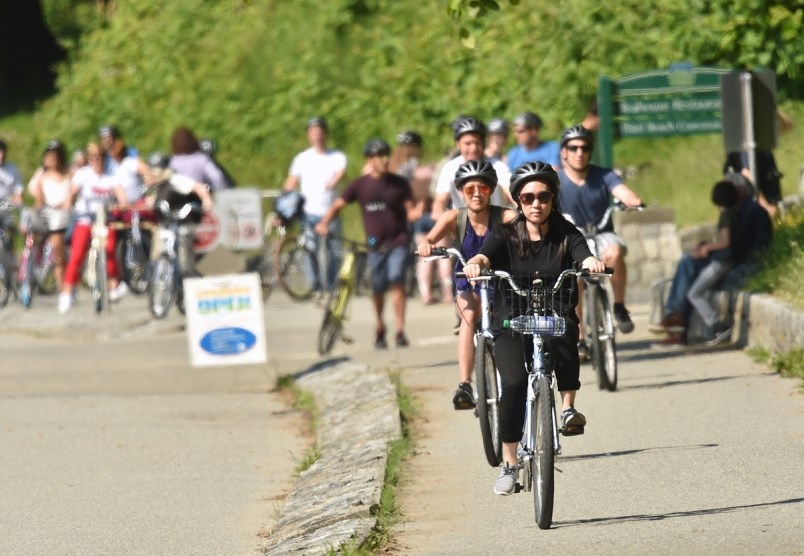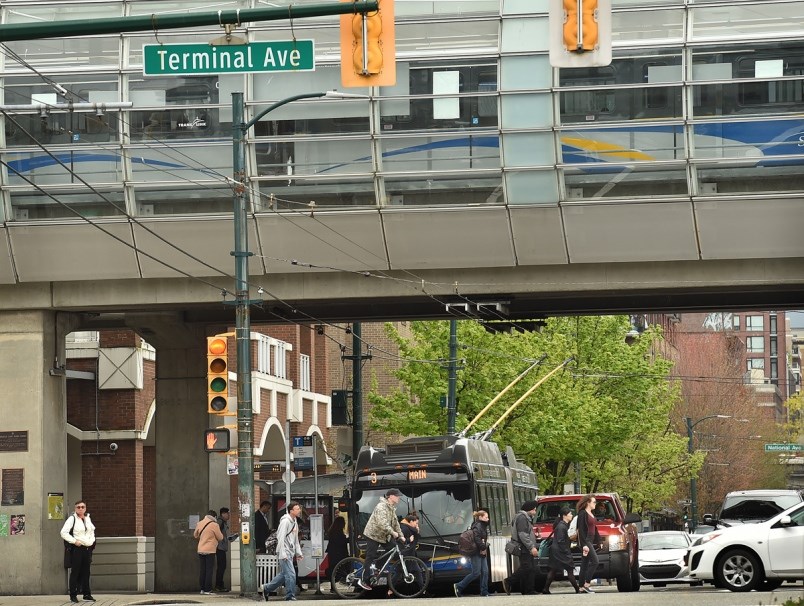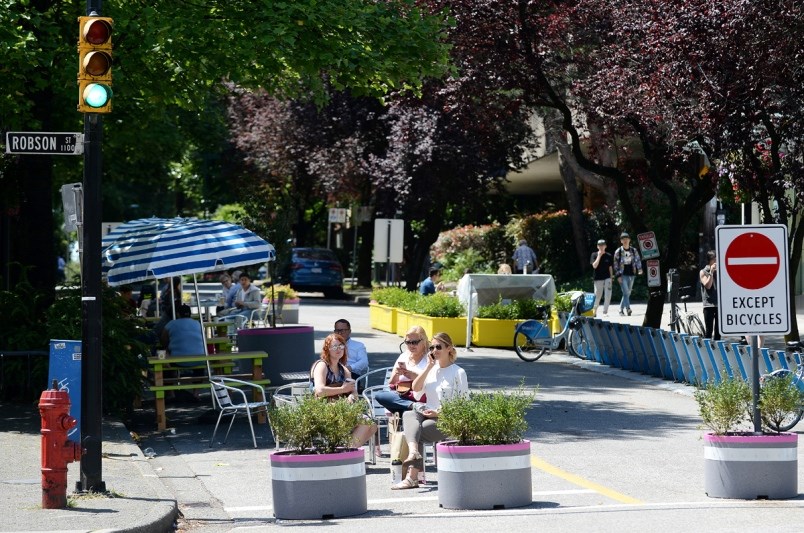Two Vancouver city councillors have separate motions going before city council this week aimed at opening up sidewalks, streets and other public places for people to eat and play.
The motions by Sarah Kirby-Yung and Lisa Dominato, which will likely be debated Wednesday, are influenced by physical distancing measures, but with an eye on making changes permanent post-pandemic.
“There’s a bigger conversation to be had here,” said Dominato, whose motion calls for reallocating road space along bikeways and areas adjacent to parks to make neighbourhoods safer for people to keep two metres apart.
“I get tired of the polarizing debate between cars and bikes. I walk a lot, I ride, I have a vehicle and I take transit a lot. To me, it’s about shared use.”
Shared use is what Kirby-Yung is calling for outside restaurants, cafes, retail businesses and craft breweries, not just in downtown but across the city.
She wants the city to speed up the time for business operators to get permits for patios, which would simultaneously allow for physical distancing and help restart the city’s economy in the warmer months.
“It helps businesses recover and hopefully it gives consumers some confidence to get out there and support those restaurants so we don’t lose them,” said Kirby-Yung, noting Provincial Health Officer Dr. Bonnie Henry has stressed the importance for people to get fresh air and sunlight for physical and mental health.
‘Commons-style eating spaces’
Kirby-Yung imagines patios and “commons-style eating spaces” set up on streets, sidewalks, laneways and public plazas, which could support nearby takeout at restaurants and cafes.
More “parklets” — patios in parking spots — outside restaurants and cafes are needed, she said, emphasizing the goal is not to impede traffic, transit, emergency vehicles or accessibility for people with disabilities.
With the cancellation of festivals throughout the city this summer, Kirby-Yung suggested there may be an opportunity to close a stretch of a main street and set up dining tables for people to eat outside.
“People keep talking about a ‘new normal,’ and I’m starting to phrase it as a ‘better normal,’” she said.
“Maybe we could be a bit more people focused in our use of public space, but also be a city more flexible and nimble in our policies.”
Dominato pointed to the busy Ontario bikeway, which links the Riley Park neighbourhood near Nat Bailey Stadium to the Olympic Village, as a stretch where there could be more sharing of road space.
She also mentioned her East Side neighbourhood, where she jogs and cycles along Wall Street. On a recent jog, she was forced to move into the street to avoid pedestrians on the sidewalk.
“That’s a perfect example of a road where you could easily add some signage that says, ‘shared use for pedestrians and cyclists, and local traffic only,’” Dominato said.
“There are different ways that we can do shared use in this city, and I think that the pandemic might be pushing us in that direction.”
Seattle closes 32 kilometres of streets
The park board’s closure of traffic to Stanley Park and the city’s reallocation of a lane on Beach Avenue are examples of that thinking, she said.
Retail, too, is an area that needs to be considered in reallocating outdoor space, Dominato said. The topic was discussed last week between city councillors and the Downtown Business Improvement Association.
“Do we reallocate some street space where we have parking to allow retailers to do retail outside?” she said, noting the need to reduce long lineups of customers.
The councillors’ motions are in line with what other cities on the West Coast have done in recent weeks, with Portland, Oakland and Seattle closing or reducing traffic on streets.
Seattle Mayor Jenny Durkan announced May 7 that nearly 32 kilometres of Seattle streets will permanently close to most vehicle traffic by the end of May.
The streets have been closed temporarily to give people more space to walk and cycle during the pandemic. Seattle will also accelerate bike infrastructure, with Durkan predicting the streets will become “treasured assets” in the designated neighbourhoods.
“We are in a marathon and not a sprint in our fight against COVID-19,” Durkan said in a news release.
“As we assess how to make the changes that have kept us safe and healthy and sustainable for the long term, we must ensure Seattle is rebuilding better than before.”
‘Slow streets’
Paul Storer, the City of Vancouver’s director of transportation, pointed to the “slow streets” concept in U.S. cities in answering questions about the city’s response to planning for a Vancouver during and after the pandemic.
Storer said the city recently imposed no-parking zones and installed local traffic-only signs around Kits Beach to keep people from flocking to the area.
The park board did the same with its parking lots at Kits Beach and at Jericho Beach and English Bay, among others. They will remain closed indefinitely.
The board announced Monday that many people are failing to comply with physical distancing, noting park rangers issued more than 11,000 warnings to groups not complying with the two-metre rule.
This past weekend alone, rangers issued more than 1,880 warnings. The board had planned to reopen the parking lots this week in time for the Victoria Day long weekend.

Storer said the city continues to work on plans to keep people at home during the pandemic, including examining the potential for changes along the city’s greenways.
“We’re looking at opportunities to create some streets that are a little bit nicer to walk and bike on, with less traffic and slower traffic, so people are more comfortable in going out in their own neighbourhoods,” he said.
More recently, the city temporarily expanded room on sidewalks into parking spots around grocery stores such as the Independent on Davie Street and Whole Foods on West Fourth Avenue to allow customers to queue up safely.
The same approach has been taken with some curb-side loading zones around the city, said Storer, noting new signs have been installed on traffic poles and meters.
On a stretch of Alexander Street, between Jackson and Dunlevy streets, picnic tables were recently placed in parking spots to allow people accessing food services in the neighbourhood a place to eat.

For the better part of two decades, the city has focused on getting more people to walk, cycle and take transit, which it has done quite successfully. New infrastructure for all three modes, which city data shows has been well-used, is visible across Vancouver.
But Storer worries those gains might be affected by the pandemic, with the fear of contracting COVID-19 keeping people off transit and forcing them back into vehicles.
“There’s a real risk that a lot of people move to driving,” he said.
“Not only does that fill up the roads really quickly and causes congestion, but it’s also really against our climate emergency goals.”
That said, Storer believes there will likely be a shift in more people working from home — as many people are doing during the pandemic — and an uptick in people riding bikes, as has been seen in recent weeks.
Whatever happens, Storer said, the pandemic has caused the city to re-examine its major planning exercises, including the fledgling Vancouver Plan and its response to council’s declared climate emergency.
“All of our systems have just had this big shock,” he said.
“Through most of our planning efforts, whether it’s transportation or whatever else, you‘re looking at trends and you’re looking at how you can affect the angle of lines on a graph and things like that. This [pandemic] is a shock like we haven’t seen before to so many parts of our city, and it is that time to take a good look at how we do things and see if there’s a better way to do them.”
Council meets at 9:30 a.m. Tuesday, but motions from Kirby-Yung and Dominato are likely to be heard at Wednesday’s meeting.
@Howellings



